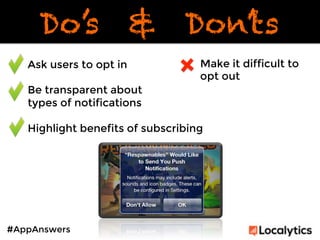2
min to read
May 1, 2024

In the realm of digital marketing, push notifications have emerged as a powerful tool for businesses to engage with their audience in real-time. However, the success of push notification campaigns hinges on getting the timing and frequency just right. Sending push notifications at the optimal time and with the right frequency can significantly impact user engagement, retention, and conversions. In this article, we will delve into strategies for achieving optimal timing and frequency in push notifications to ensure they are effective, relevant, and well-received by users.
The Importance of Timing and Frequency in Push Notifications
Timing and frequency are critical factors in the success of push notification campaigns. Sending notifications at the right time when users are most likely to be receptive can increase open rates and engagement. Likewise, striking the right balance in terms of frequency - not too few to be forgotten, and not too many to be annoying - is key to maintaining user interest and avoiding opt-outs. By optimizing timing and frequency, businesses can deliver push notifications that are timely, relevant, and valuable to users.
Strategies for Optimal Timing and Frequency in Push Notifications
1. Understand Your Audience
Before determining the timing and frequency of your push notifications, it's essential to understand your audience's behavior, preferences, and time zones. Analyze user data to identify peak engagement times, such as when users are most active on your app or website, and tailor your push notification schedule accordingly.
2. Segmentation and Personalization
Segment your audience based on demographics, behavior, and preferences to deliver personalized push notifications at the right time. By targeting specific user segments with tailored messages, you can ensure that notifications are relevant and timely, increasing the likelihood of user engagement.
3. A/B Testing
Conduct A/B testing to experiment with different timing and frequency strategies for your push notifications. Test variations in timing, such as morning vs. evening, and frequency, such as daily vs. weekly, to identify what resonates best with your audience and drives the highest engagement.
4. Utilize Automation
Use automation tools to schedule push notifications at optimal times based on user behavior and preferences. Automation can help ensure that notifications are sent when users are most likely to engage, without requiring manual intervention for each message.
5. Monitor Performance Metrics
Regularly monitor key performance metrics such as open rates, click-through rates, and conversion rates to gauge the effectiveness of your push notification timing and frequency strategies. Use data-driven insights to refine your approach and optimize for better results.
Best Practices for Timing and Frequency Optimization
1. Morning vs. Evening
Consider sending push notifications in the morning when users are starting their day and may be more receptive to updates or promotions. Alternatively, evening notifications can catch users during their downtime and may lead to higher engagement.
2. Weekday vs. Weekend
Tailor your push notification schedule based on weekdays vs. weekends. Users' behavior and availability may vary during the week vs. on weekends, so adjust your timing and frequency accordingly to maximize engagement.
3. Event-Based Timing
Leverage event-based timing for push notifications related to specific occasions, holidays, or user actions. Sending notifications at the right moment, such as after a user completes a purchase or achieves a milestone, can enhance relevance and drive conversions.
4. Geo-Targeted Timing
Utilize geo-targeting to send push notifications at the optimal time based on users' location. Consider time zone differences and local preferences to ensure notifications are delivered when users are most likely to engage.
5. Consistent but Not Overwhelming Frequency
Maintain a consistent but not overwhelming frequency of push notifications. Avoid bombarding users with too many messages, as this can lead to opt-outs and decreased engagement. Strike a balance that keeps users informed and engaged without overwhelming them.
Case Studies and Success Stories
1. E-commerce Platform
An e-commerce platform optimized its push notification timing by sending reminders about abandoned carts in the evening when users were more likely to complete their purchases. This strategy led to a 20% increase in conversion rates and a 15% decrease in cart abandonment.
2. Fitness App
A fitness app adjusted its push notification frequency by sending workout reminders in the morning and progress updates in the evening. By tailoring the timing and frequency of notifications to users' daily routines, the app saw a 25% increase in user engagement and a 10% increase in app retention.
3. Travel App
A travel app implemented geo-targeted timing for its push notifications, sending destination recommendations based on users' current location. By delivering timely and relevant notifications, the app achieved a 30% increase in click-through rates and a 20% increase in bookings.
Conclusion

Timing and frequency are crucial elements in the success of push notification campaigns. By optimizing when and how often notifications are sent, businesses can enhance user engagement, retention, and conversions. Understanding your audience, segmenting users, conducting A/B testing, utilizing automation, and monitoring performance metrics are key strategies for achieving optimal timing and frequency in push notifications. By following best practices and learning from successful case studies, businesses can crack the code for effective push notification timing and frequency, ensuring that messages are well-received, relevant, and drive meaningful interactions with users.



